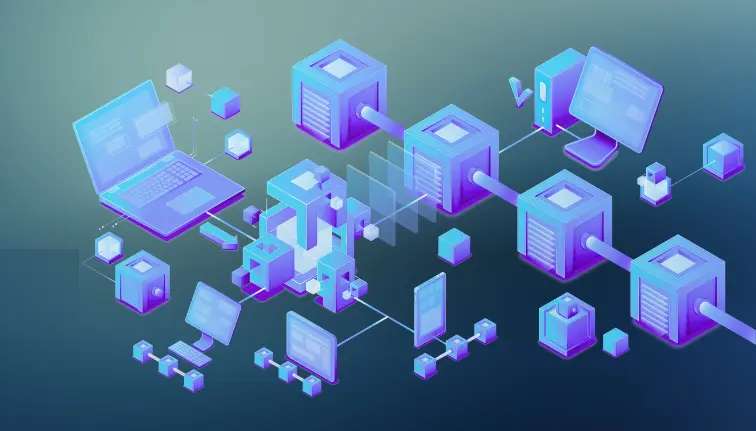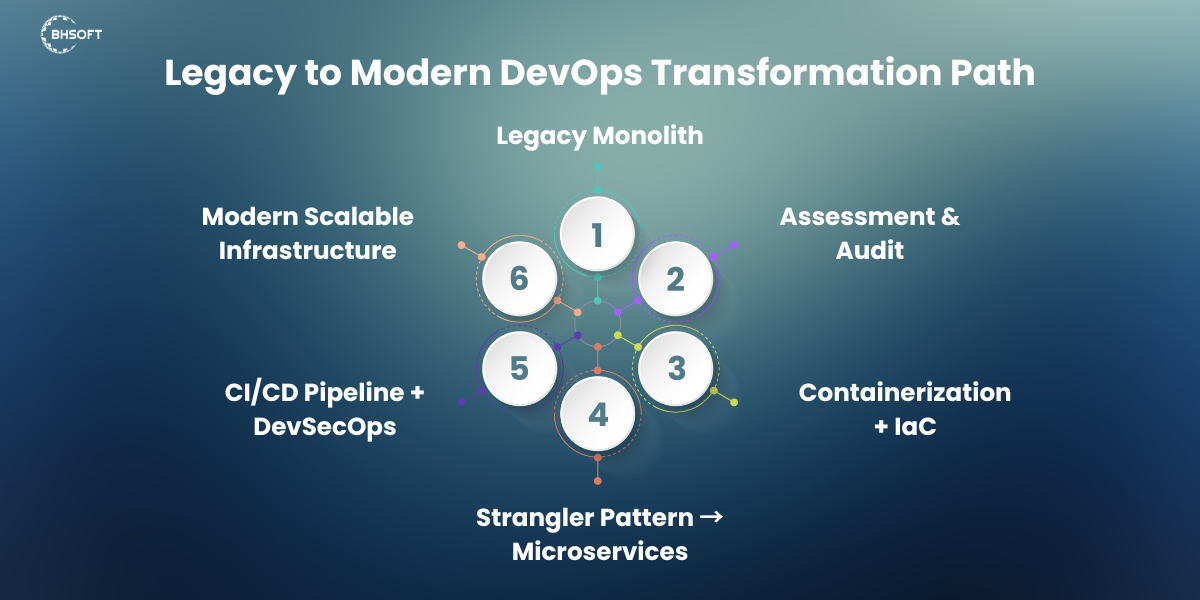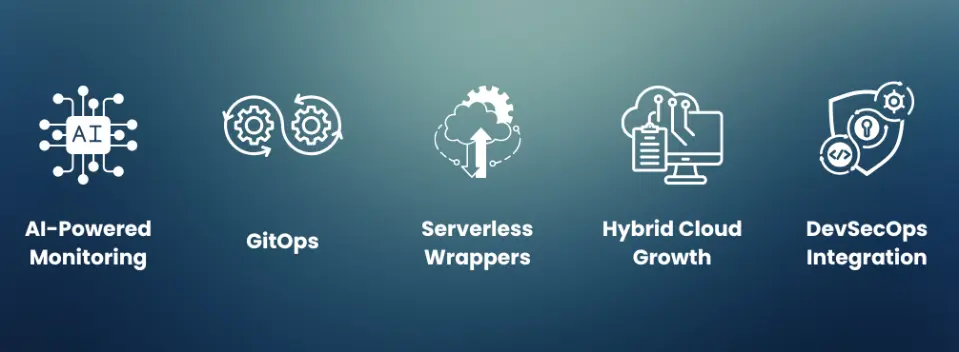Home > Insight > Technology
Best Practices for DevOps in Legacy System Migration
Audio description available
5 minutes read
It’s 2026, and somehow, legacy systems are still everywhere. Despite the rapid adoption of cloud-native architectures and microservices, many enterprises continue to rely on mission-critical workloads running on decades-old technology.
Modernizing these systems isn’t just a tech upgrade — it’s a necessity for survival. According to a recent IDC report, organizations spend 60–80% of their IT budgets simply maintaining legacy applications. And that doesn’t even account for the massive opportunity cost caused by slow innovation and poor scalability.
So how can enterprises bring these outdated systems into the modern era without disrupting operations? The answer lies in leveraging DevOps in legacy system migration, supported by end-to-end DevOps services that streamline integration, accelerate delivery, and ensure a smooth transition to modern architecture.
The Legacy Problem: Still Here, Still Expensive
Legacy systems are the old-school applications and infrastructure still running on outdated languages, monolithic architectures, and on-premise hardware. Think COBOL apps on mainframes or tightly coupled Java systems built in the early 2000s. They're expensive to maintain, hard to scale, and even harder to integrate. But they’re also embedded deep into core business operations. You can’t just pull the plug.
And yet, sticking with them costs more than just money.
The Financial Burden
|
Metric |
Updated Data & Source |
Impact |
|
Maintenance Spending |
80% of IT budgets in many organisations are dedicated just to "keeping the lights on"—maintaining legacy systems, rather than innovation. (Source: Gartner/Industry Reports) |
Only 20% of resources are left for developing new, competitive features and systems. |
|
Technical Debt |
Global technical debt is estimated to be over $3 trillion, largely accumulated through maintaining, patching, and failing to replace old codebases. (Source: Capgemini/Industry Analysis) |
This debt cripples future agility and dramatically increases the cost of change. |
The Operational & Security Risks
|
Metric |
Updated Data & Source |
Impact |
|
Deployment Speed |
Companies reliant on legacy tech experience 30% slower deployment cycles compared to those modernising their IT landscape. (Source: Gartner) |
Slower time-to-market (TTM) and reduced competitive advantage. |
|
Unplanned Downtime |
These organisations are 2.5x more likely to suffer from unplanned downtime due to the fragility and complexity of old infrastructure. (Source: Gartner) |
Direct revenue loss and severe reputational damage. |
|
Cybersecurity Gap |
70% of successful cyberattacks exploit known vulnerabilities in legacy systems and unpatched software, which often receive less vendor support. (Source: IBM Security/Verizon DBIR) |
Increased regulatory fines and greater risk exposure. |
The Talent Challenge
|
Metric |
Updated Data & Source |
Impact |
|
Skills Shortage |
The average age of COBOL programmers is now 55+, with a shrinking pool of new talent interested in maintaining legacy languages. (Source: Academic & Industry Surveys) |
Creates critical key-person dependencies and makes finding external support prohibitively expensive. |
Why DevOps Is the Missing Link
If legacy systems are the problem, DevOps is the way out, or at least, the way forward.
Unlike traditional migration approaches that try to rip and replace, DevOps encourages iterative, low-risk transformation. It’s not about rewriting everything from scratch. It’s about evolving what already works, safely, predictably, and with automation doing most of the heavy lifting.
With DevOps, you can:
- Build automated pipelines that test and deploy legacy components safely — a key strength of DevOps in legacy system migration.
- Containerize parts of your system to make them portable and scalable.
- Improve collaboration between development, operations, and security teams.
- Move faster without breaking everything.
This isn’t just theory. Companies like Capital One and ING have adopted DevOps to modernize their legacy banking platforms, cutting deployment times from weeks to hours while reducing outages by over 80%.
Learn more: Custom WordPress development services

What a DevOps-Driven Migration Looks Like
Here’s how smart organizations are tackling legacy system migration — not with giant waterfall projects, but through incremental, strategic steps.
Start With an Honest Assessment
Before you can fix anything, you need to understand what you’re working with. Conduct a technical audit of your legacy systems:
- What are the critical components?
- Where’s the highest risk of failure?
- What tech debt has piled up?
Tools like CAST Highlight or CodeScene can help visualize dependencies and complexity so you don’t walk in blind.
Break It Up With the Strangler Pattern
Don’t try to rebuild the whole system at once. It rarely ends well.
Instead, use the strangler fig pattern, slowly replace pieces of the legacy app with new services that sit alongside it. Over time, the legacy part “shrinks” and the new system grows.
This gives you quick wins, reduces risk, and keeps the business running during migration.

Use Containers (Yes, Even for Old Stuff)
You’d be surprised how many legacy apps can be containerized — even if they weren’t built for it. By wrapping them in Docker and managing them with Kubernetes, you can:
- Run them consistently across environments.
- Isolate them for better security.
- Scale them without rewriting the entire codebase.
Companies like PayPal and Adobe have used this approach to migrate old Java and .NET systems to containerized environments with minimal downtime.
Automate Everything You Can
One of the biggest wins with DevOps in legacy system migration? Automation — enabling consistent deployments across fragile systems.
Use tools like Jenkins, GitLab CI/CD, or GitHub Actions to:
- Run automated builds.
- Run unit and regression tests (even on legacy codebases).
- Deploy to staging and production without manual steps.
It might take effort to get pipelines running at first, especially if your legacy application has no test coverage, but the long-term payoff is huge.
Infrastructure as Code (IaC): Make Environments Reproducible
Gone are the days of “works on my machine.” With Terraform, Pulumi, or Ansible, you can define servers, databases, and networks as code.
This is especially useful in legacy migrations where environments often differ wildly between dev, test, and production.
Ready to modernize without the meltdown? Talk to our experts
Overcoming The Tough Stuff: Real Challenges, Real Fixes
Let’s be real: modernizing legacy application isn’t a cakewalk. Here’s what tends to go wrong and how to fix it.
Cultural Resistance
Some engineers have been maintaining the same system for 20 years. They’re not always excited about automation or cloud-native anything.
→ Fix: Invest in internal DevOps champions, provide training, and let teams see small wins before expecting big buy-in.
Security Holes
Legacy apps often lack basic security measures, and DevOps can expose those gaps fast.
→ Fix: Integrate DevSecOps early. Use tools like Snyk or SonarQube to scan for vulnerabilities before every release. Automate compliance checks in your pipeline.
No Documentation
“Steve built this in 2006, and no one knows how it works.” Sound familiar?
→ Fix: Use automated code analysis, dependency scanners, and interview your own team. Sometimes, documentation lives in heads — capture it.

What’s Changing in 2026?
The DevOps world moves fast. As more enterprises adopt hybrid cloud and AI-driven tooling, DevOps in legacy system migration is evolving from theory to an enterprise standard.
- AI-driven observability is helping teams monitor legacy systems more proactively (think Datadog with anomaly detection or Dynatrace with automated root cause analysis).
- GitOps is gaining traction, making infrastructure changes fully traceable and reversible.
- Serverless wrappers are emerging to modernize interactions with legacy code — without rewriting it.
- Hybrid cloud is the new normal: 67% of enterprises are now using both on-prem and cloud systems for gradual migrations
DevOps Migration Checklist
Let’s wrap with a quick checklist. If you’re implementing DevOps in legacy system migration, ask yourself:
- Have we mapped all dependencies and risks?
- Are we starting with a non-critical service to test migration?
- Do we have automated tests and CI/CD in place?
- Are we using containers or IaC to modernize deployments?
- Is security integrated into our pipeline from day one?
- Are we measuring success with clear metrics (uptime, lead time, deployment frequency)?
If the answer to any of these is “no,” you’ve got your next sprint goal.
Final Thoughts: Migrate What Matters, Not Everything
Legacy systems are stubborn, but they’re not immovable. With the right strategy, you can modernize critical infrastructure without risking your entire business. And in 2026, DevOps in legacy system migration is the smartest, safest way to make that happen.
At BHSOFT, we specialize in legacy system transformation using proven DevOps methodologies. From containerizing monolithic apps to implementing CI/CD pipelines and replatforming with minimal disruption, our team specializes in legacy system modernization that works, fast, secure, and scalable.
If you're planning DevOps in legacy system migration, don’t go it alone.
Contact us today to learn how we can help you future-proof your operations and drive digital transformation without the headaches.

